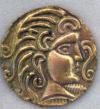When Modern Eurasia Was Born

This image shows a typical group of Danish Bronze Age barrows from ca. 3,500-3,100 BP. Normally they were 3-5 meters high, constructed with cut out grass turfs (sods). One barrow would demand 3 hectares of grazing land. In Denmark 50,000 such barrows were constructed during the period 3,500- 3,100 BP for the leading chiefly lineages.
Credit: Kristian Kristiansen
- Both archaeologists and linguists have had theories about how cultures and languages have spread in our part of the world. We geneticists have now collaborated with them to publish an explanation based on a record amount of DNA-analyses of skeletons from the Bronze Age.
So far the archaeologists have been divided into two different camps. Professor Kristian Kristiansen of the University of Gothenburg, who initiated the project together with Lundbeck Foundation Professor Eske Willerslev says: The driving force in our study was to understand the big economical and social changes that happened at the beginning of the third millennium BC, spanning the Urals to Scandinavia. The old Neolithic farming cultures were replaced by a completely new perception of family, property and personhood. I and other archaeologists share the opinion that these changes came about as a result of massive migrations.
One of the main findings from the study is how these migrations resulted in huge changes to the European gene-pool, in particular conferring a large degree of admixture on the present populations. Genetically speaking, ancient Europeans from the time post these migrations are much more similar to modern Europeans than those prior the Bronze Age.
Mobile warrior people
The re-writing of the genetic map began in the early Bronze Age, about 5,000 years ago. From the steppes in the Caucasus, the Yamnaya Culture migrated principally westward into North- and Central Europe, and to a lesser degree, into western Siberia. Yamnaya was characterized by a new system of family and property. In northern Europe the Yamnaya mixed with the Stone Age people who inhabited this region and along the way established the Corded Ware Culture, which genetically speaking resembles present day Europeans living north of the Alps today.
This image shows a Yamnaya skull from the Samara region colored with red ochre.
Credit: Natalia Shishlina
During the last part of the Bronze Age, and at the beginning of the Iron Age, East Asian peoples arrived in Central Asia. Here it is not genetic admixture we see, but rather a replacement of genes. The European genes in the area disappear.
A new scale
These new results derive from DNA-analyses of skeletons excavated across large areas of Europe and Central Asia, thus enabling these crucial glimpses into the dynamics of the Bronze Age. In addition to the population movement insights, the data also held other surprises. For example, contrary to the research team’s expectations, the data revealed that lactose tolerance rose to high frequency in Europeans, in comparison to prior belief that it evolved earlier in time (5,000 – 7,000 years ago).
Contacts and sources:
Morten Allentoft
University of Copenhagen
Source: http://www.ineffableisland.com/2015/06/when-modern-eurasia-was-born.html
Anyone can join.
Anyone can contribute.
Anyone can become informed about their world.
"United We Stand" Click Here To Create Your Personal Citizen Journalist Account Today, Be Sure To Invite Your Friends.
Before It’s News® is a community of individuals who report on what’s going on around them, from all around the world. Anyone can join. Anyone can contribute. Anyone can become informed about their world. "United We Stand" Click Here To Create Your Personal Citizen Journalist Account Today, Be Sure To Invite Your Friends.
LION'S MANE PRODUCT
Try Our Lion’s Mane WHOLE MIND Nootropic Blend 60 Capsules
Mushrooms are having a moment. One fabulous fungus in particular, lion’s mane, may help improve memory, depression and anxiety symptoms. They are also an excellent source of nutrients that show promise as a therapy for dementia, and other neurodegenerative diseases. If you’re living with anxiety or depression, you may be curious about all the therapy options out there — including the natural ones.Our Lion’s Mane WHOLE MIND Nootropic Blend has been formulated to utilize the potency of Lion’s mane but also include the benefits of four other Highly Beneficial Mushrooms. Synergistically, they work together to Build your health through improving cognitive function and immunity regardless of your age. Our Nootropic not only improves your Cognitive Function and Activates your Immune System, but it benefits growth of Essential Gut Flora, further enhancing your Vitality.
Our Formula includes: Lion’s Mane Mushrooms which Increase Brain Power through nerve growth, lessen anxiety, reduce depression, and improve concentration. Its an excellent adaptogen, promotes sleep and improves immunity. Shiitake Mushrooms which Fight cancer cells and infectious disease, boost the immune system, promotes brain function, and serves as a source of B vitamins. Maitake Mushrooms which regulate blood sugar levels of diabetics, reduce hypertension and boosts the immune system. Reishi Mushrooms which Fight inflammation, liver disease, fatigue, tumor growth and cancer. They Improve skin disorders and soothes digestive problems, stomach ulcers and leaky gut syndrome. Chaga Mushrooms which have anti-aging effects, boost immune function, improve stamina and athletic performance, even act as a natural aphrodisiac, fighting diabetes and improving liver function. Try Our Lion’s Mane WHOLE MIND Nootropic Blend 60 Capsules Today. Be 100% Satisfied or Receive a Full Money Back Guarantee. Order Yours Today by Following This Link.






